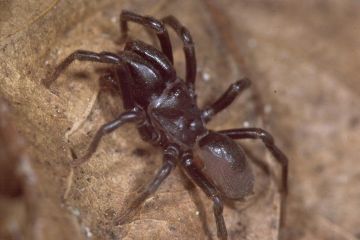Summary for Atypus affinis (Araneae)
National Distribution
Terms of Use. Double-click on map to go to region

Explore Regional Distribution
View notes or log on and add a note on this species
About this species
Recorded altitude range0m to 294m
Species text
DistributionThe species is widely distributed in southern Britain but there are scattered coastal records as far north as south-west Scotland. It is widespread in western and central Europe as far north as Denmark and Sweden where it is listed in the Red List (Gardenfors 2000).
Habitat and ecology
Atypus is typically found in unimproved open habitats such as heathland, chalk grassland or other old grasslands. Most of its tubular web is underground and a friable substrate will aid burrowing. In heathland the spider prefers loose sand with young heather hanging loosely over it, and fairly free from moss and other close vegetation (Dallas 1938) and gravel banks covered with tufts of heather (Main 1921-23). In grassland the spider often makes its tubes in the ground in undisturbed areas around the edge of scrub and at the base of anthills. The silk tube is well camouflaged with bits of earth and debris and the spider can be difficult to find. In coastal areas the webs may be found along the edges of large rocks and sites on the west coast are often associated with rock outcrops, the webs at the base protected by the rocks from grazing, trampling and the weather. The discovery on a slope by the side of a footpath of scattered detached tubes and small mounds of soil particles above silk-lined burrows is described by Gallon (2001a). He suggests the behaviour is probably the result of concerted burrow excavation and enlargement. The life of the spider is long, possibly up to 7 or even 8 years (Bristowe 1958) and it spends almost all this time inside its purse-web. The main prey seems to comprise beetles, bees, flies, earwigs and woodlice. Males can be trapped in pitfalls and may be numerous at favourable sites. The presence of grazing may be a factor explaining an association with the edge of scrub. There are presumably significant resource implications for the rebuilding of purse-webs after trampling. Atypus must therefore require relatively undisturbed habitats. Dallas (1938) had already identified wear and tear due to increased trampling, as the probable cause of the loss of some colonies in the London district. Females are adult all year. Bristowe (1958) states that during the winter months from about November to early February Atypus is in a state of hibernation at the bottom of the tube, and the aerial portion remains in a collapsed condition. At one site with a large population, occasional males have been trapped in the winter, but there is a main peak for September-October with smaller numbers in April and May. The Nationally Scarce (Notable A) spider hunting wasp Aporus unicolor uses Atypus as its host, which it locates and paralyses within the spider's silken burrow (Edwards 1997).
Status
There has been a large apparent decline, hence a Watching Brief should be kept on this species. It is generally scarce and very local. Large populations have been recorded but it is likely that much of our modern landscape supports only small isolated colonies.
Threats
The association with old and undisturbed habitats and the dramatic loss of heathland and unimproved grasslands in much of southern England mean that many colonies are isolated and liable to local extinction. Intensive grazing and public amenity pressure will threaten the survival of colonies through the effects of trampling.
Management and conservation
The spider is vulnerable to inappropriate management. Without management to control scrub, open habitat and open sandy or gravel banks will disappear. On the other hand, trampling, intensive grazing and the cutting of grasslands is also likely to destroy colonies. Occasional management to control scrub would seem to be most appropriate.
Text based on Dawson, I.K., Harvey, P.R., Merrett, P. & Russell-Smith, A.R. (in prep.). References
Account last edited by System Administrator at 07:16 on Wed 5th Jan 2022.
Adult Season
Habitats
background methodology
Recorded management for locations with Atypus affinis
Recorded substrate and hydrology for locations with Atypus affinis
Images
please log on and upload a new image for this speciesSee also A-Z Species Index - A-Z Picture Index - | next species





























